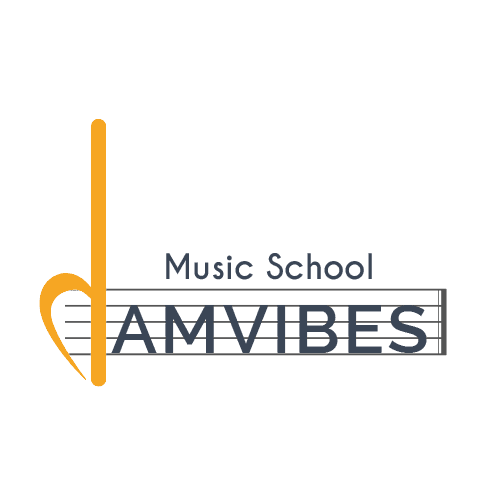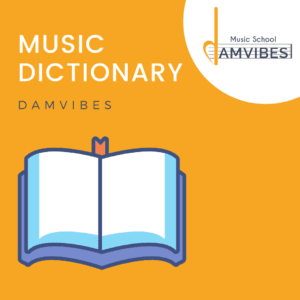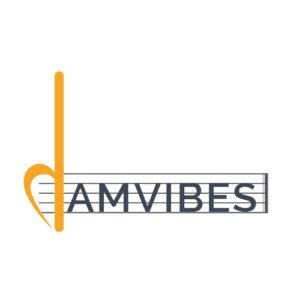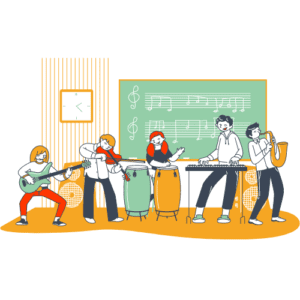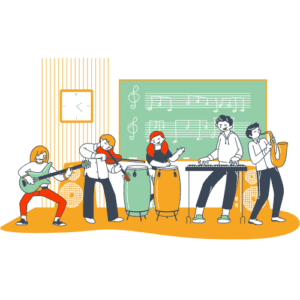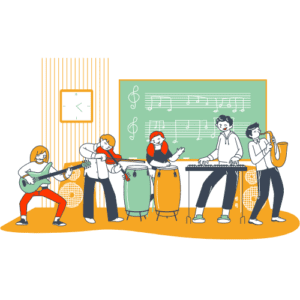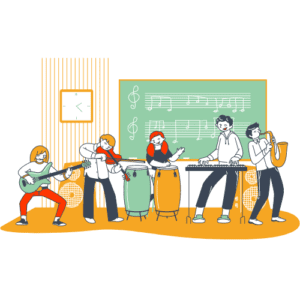Introduction to our Dictionary of Music Terms
Music glossary
Accelerando
Increase tempo(speed) gradually
Accent
Emphasize certain note
Accent (natural)
The first beat of a measure is naturally accented
Adagio
Slow
Agitato
Agitated
Allegro
Moderately fast
Andante
In italian it would mean “walking”
Apoggiatura
Note that doesn’t belong to the chord it is sounding in the background. An apoggiatura tends to “resolve” in a note that belongs to the chord it is sounding
Arpeggio
A chord in which its notes are played one after the other
Articulation
Everything related to the length of the notes. For example, staccato, legato or portato
Bar
Fragment of music that coincides with the time signature
Beat
Music has “heart beats”. What you normally do when you want to accompany a music with clapping
Cadence
Sequence of chords that sounds at the end of a musical phrase
Cadenza
Fragment that is played freely
Canon
Formed by 2 or more melodies. A melody is accompanied by that same melody starting a bit later
Chord
Three or more notes played at the same time
Chromatic
Certain number of notes that have one half-tone distance to each other
Clef
Sign that indicates the register (number of notes that fragment or piece will cover)
Coda
Conclusive part of a fragment or piece
Crescendo
Play louder gradually
Da capo
Start playing from the beginning
Dominant
Chord that is formed over the fifth note of the scale
Diminuendo
Play softer gradually
Dynamics
Everything related to the intensity of the sound
Fermata
The duration of the note/chord in which this sign is played is longer
Flat
Play that note half a tone lower
Forte
Loud
Fortepiano
Play loud and right after play soft
Glissando
A continuous sliding from one pitch to another
Key
Pieces are theoretically written using only 7 notes. Each combination has different key name. In practice, you can change the key momentaneously or even change radically the key in the middle of the piece.
Largo
Very slow
Leggiero
Light, as the opposite of heavy
Legato
Notes played without any sound gap. This is to say, link the notes as much as you can.
Major
Major refers to a chord that has certain pattern: From the fundamental note to the second note there is a major third (4 half tones) and from the second note to the third note there is a minor third (3 half tones)
Minor
Minor refers to a chord that has certain pattern: From the fundamental note to the second note there is a minor third (3 half tones) and from the second note to the third note there is a major third (4 half tones)
Motif
Sequence of notes that has certain sense and repeats several or many times in the piece
Natural
A note that has no sharps or flats
Octave
Distance of 12 half tones. For example, a note that is in the center of a piano (for example C) is one octave distance to the next C of the piano
Ostinato
Fragment of sequence of notes that repeats several or many times
Pianissimo
Very soft
Ritardando
Play slower gradually
Scale
Determined number of notes that generally defines the key of a piece
Sharp
Symbol that is used to indicate that that particular note needs to be played 1 half tone higher.
Staccato
Make the sound shorter (respecting the tempo).
Tempo
Speed of the music
Time signature
Symbol composed by two numbers. It indicated the organization of the rhythm. For example 4/4 time signature means that every bar has 4 quarter notes
Trill
Embellishment of a note. You should play one note and the note above or below, consecutively and fast for 2 or more rows.
Triplet
Three notes played in the time of two of the same kind. For example, where you play two eighth notes, play three equal notes.
Tonic
Chord that is formed from the first note of the scale.
Unison
Two melodies that play exactly the same notes
Vibrato
Emebellishment added to one note. Technically a vibrato can be performed through small regular changes of the pitch, but also through regular changes of the intensity of the sound.
Vivace
Lively
Are these all terms in music theory?
Music is so wide that we will never cover everything. If you want to go deeper in this topic you can check most-used music terms.
